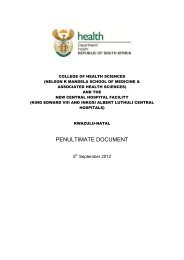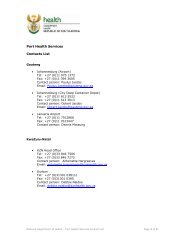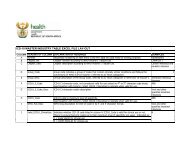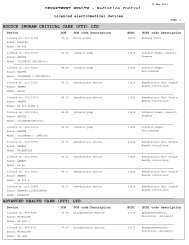National Norms and Standards relating to Environmental Health
National Norms and Standards relating to Environmental Health
National Norms and Standards relating to Environmental Health
Create successful ePaper yourself
Turn your PDF publications into a flip-book with our unique Google optimized e-Paper software.
19. Drinking water on the ship <strong>and</strong> at the port must regularly be tested <strong>to</strong> ensure that it is fit for humanconsumption both on an operational level <strong>and</strong> on compliance level.20. Documentation for water quality moni<strong>to</strong>ring must be kept for assurance <strong>and</strong> analysis in the event ofan incident.21. Documents of inspection, maintenance, cleaning, disinfection (<strong>to</strong> include concentration <strong>and</strong> contacttime of disinfectant) <strong>and</strong> flushing should be kept <strong>and</strong> available for 12 months.22. Sampling must be done by Port <strong>Health</strong> Officials or other professionally trained personnel only.23. Sampling for ship water supply system, potable water for human consumption on the ship, for waterwith a temperature of between 25 °C <strong>and</strong> 50 °C must be done as prescribed in the GDWQ as well asin ISO 19458.24. Port <strong>Health</strong> Officials <strong>and</strong> the ship opera<strong>to</strong>rs must have basic water treatment calibrated equipment ath<strong>and</strong> for basic testing of turbidity, PH <strong>and</strong> disinfectant residual.Bunkering of ship water1. Bunkering of water must be done in accordance with the st<strong>and</strong>ards as set out in Guideline 2.3 of theWHO. Guide <strong>to</strong> Ship Sanitation. 3 rd edition.2. The ships opera<strong>to</strong>r must ensure that the quality <strong>and</strong> source water for ships conforms <strong>to</strong> the SANS241 before bunkering.3. Port <strong>Health</strong> Officials must conduct compliance moni<strong>to</strong>ring <strong>to</strong> ensure no contamination of water takesplace during bunkering.Water production on board1. When sea water is <strong>to</strong> be treated on board sea for use as potable water, the processes conductedshould be in accordance <strong>to</strong> the requirements as specified in Guideline2.3 of the WHO. Guide <strong>to</strong> ShipSanitation. 3 rd edition.Potable water s<strong>to</strong>rage1. The s<strong>to</strong>rage of potable water on board should be done in accordance <strong>to</strong> the requirements asspecified Guideline 2.3 of the WHO. Guide <strong>to</strong> Ship Sanitation <strong>to</strong> prevent contamination of water.2. Port <strong>Health</strong> Officials must inspect empty tanks on a regular basis <strong>and</strong> take microbiological <strong>and</strong>chemical samples of the water.Ballast waterBallast water can carry hazards such as <strong>to</strong>xicogenic vibrio cholera that can be associated with choleraoutbreaks in port areas.1. Ballast water must be treated on board <strong>and</strong> sampled for the presence of hazardous pathogens <strong>and</strong>harmful organisms before it can be discharged in<strong>to</strong> the marine environment.2. Ships should not be allowed <strong>to</strong> discharge ballast water or any liquid containing <strong>to</strong>xic waste or anyform of contamination, in areas where water for water supply is drawn or any other restricted area forthe disposal of waste by the local authority.3. Ballast water must comply with specified concentrations in terms of human health st<strong>and</strong>ards asoutlined in the WHO 4 th Edition Guidelines for drinking water.4. Hoses used <strong>to</strong> allow rapid discharge ballast water must be suitably labeled “FOR WASTEDISCHARGE ONLY”.5. Ballast water onboard ship must conform <strong>to</strong> the requirements as specified in the WHO Guide <strong>to</strong> ShipSanitation <strong>and</strong> the H<strong>and</strong>book for Inspection of Ships <strong>and</strong> Issuance of Ship Sanitation Certificates;6. An approved Ballast water management plan must be in place;7. A ballast water record book must be kept;8. Ballast water must be safely treated <strong>and</strong> disposed off.DOH. <strong>Norms</strong> <strong>and</strong> st<strong>and</strong>ards for environmental health in South Africa Feb 2013 88


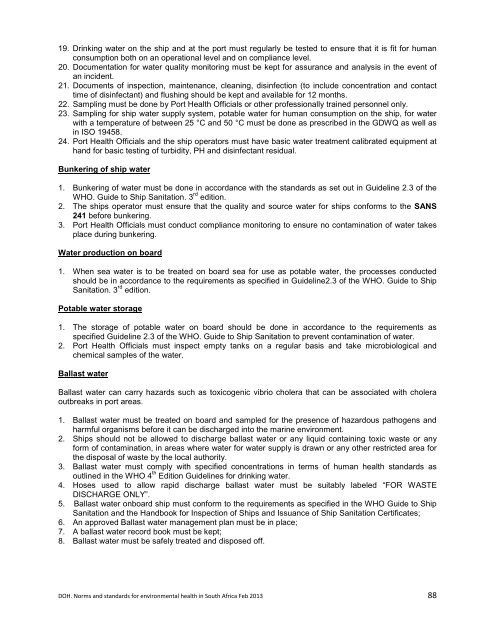
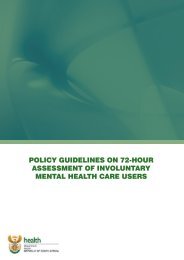

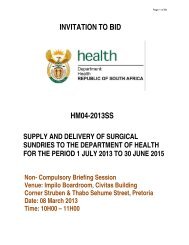
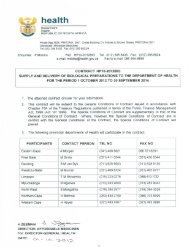
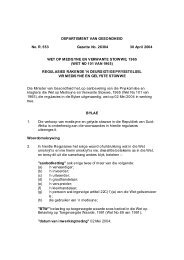
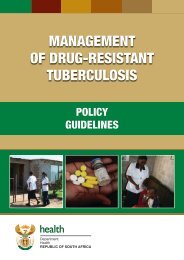
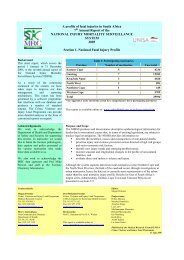
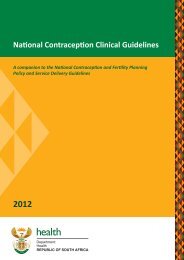
![A monograph of the management of postpartum haemorrhage [2011]](https://img.yumpu.com/15578784/1/184x260/a-monograph-of-the-management-of-postpartum-haemorrhage-2011.jpg?quality=85)
